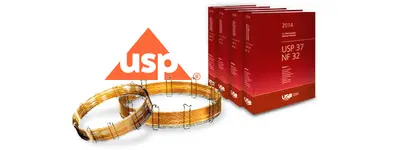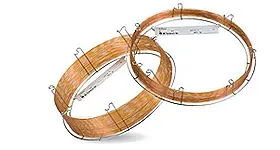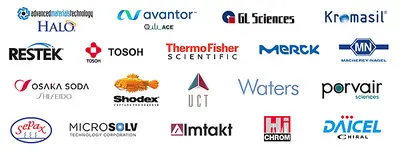Auschecken über Ihr Konto
Als Neukunde auschecken
Ein Konto zu erstellen hat viele Vorteile:
- Bestellungen und Sendungen verfolgen
- Alte Bestellungen einsehen
- Schneller zur Kasse gehen
GC USP-Listing nach <621>
USP-Listing für GC-Säulen
Die folgende offizielle Liste der GC-Packungsmaterialien gemäß USP 621 versteht sich als Auswahlhilfe bei der Wahl einer passenden Säule für die Umsetzung einer USP-Methode. Alle aufgeführten Säulen können direkt bei MZ-Analysentechnik GmbH bestellt werden; sofern existent findet sich zu jeder Methode mindestens ein Packungsmaterial. Die Liste erhebt keinen Anspruch darauf, alle USP-konformen Säulen aufzuführen. Im Sinne möglichst reibungsloser Arbeitsabläufe haben wir den Fokus auf die Auflistung von schnell und zuverlässig lieferbaren Säulen gelegt. Dies garantiert eine möglichst unterbrechungsfreie Arbeit, falls eine Säule ersetzt werden muss.
| USP Nummer | Beschreibung | Säulenempfehlung | |
|---|---|---|---|
| G1 | Dimethylpolysiloxane oil. | AT-1 DB-1 GsBP-1 InertCap 1 | MEGA-1 Optima-1 Rtx-1 |
| G2 | Dimethylpolysiloxane gum. | AT-1 DB-1 GsBP-1 InertCap 1 | MEGA-1 Optima-1 Rtx-1 |
| G3 | 50% Phenyl-50% methylpolysiloxane. | AT-50 GsBP-17 InertCap 17 MEGA-17 | Optima 17 OV-17 Rtx-17 TRACE TR-5MS |
| G4 | Diethylene glycol succinate polyester. | DEGS (Supelco, GS-Tek) Rt-DEGS | |
| G5 | Not less than 70% of 3-Cyanopropylpolysiloxane. | AT-Silar BPX70 CP-Sil 88 GsBP-23 | MEGA-50 Rt-2340 TC2560 TRACE TR-FAME |
| G6 | Trifluoropropylmethylpolysiloxane. | AT-210 DB-200 GsBP-200 HP-210 InertCap 210 | MEGA-200 OV-210 Rtx-200 SP-2401 |
| G7 | 50% 3-Cyanopropyl-50% phenylmethylsilicone. | DB-225 GsBP-225MS HP-225 InertCap 225 | MEGA-225 Rtx-225 SP-2300 SPB-225 |
| G8 | 80% Bis(3-Cyanopropyl-20% 3-cyanopropylphenylpolysiloxane (percentages refer to molar substitution). | CP-Sil 88 DB-23 GsBP-88 HP-88 | MEGA-10 FAMEs Rtx-2330 SP-2330 |
| G9 | Methylvinylpolysiloxane. | AT-1 CP-Sil 5 CB DB-1 Equity-1 GsBP-1 | HP-1 MEGA-1 Optima 1 Rtx-1 SPB-1 |
| G10 | Polyamide formed by reacting a C36 dicarboxylic acid with 1,3-di-4-piperidylpropane and piperidine in the respective mole ratios of 1.00:0.90:0.20. | Polyamide | |
| G11 | Bis(2-ethylhexyl)sebacate polyester. | Bis(2-thylhexyl)sebacate polyester Di(2-ethylhexyl)sebacate | |
| G12 | Phenyldiethanolamine succinate polyester. | Phenyldiethanolamine succinate Phenyldiethanolamine succinate polyester | |
| G13 | Sorbitol. | Sorbitol | |
| G14 | Polyethylene glycol (av. mol. wt. of 950 to 1050). | Carbowax 1000 MEGA-WAX 1000 | |
| G15 | Polyethylene glycol (av. mol. wt. of 3000 to 3700). | Carbowax 4000 | |
| G16 | Polyethylene glycol compound (av. Mol. wwt. About 15,000). A high molecular weight compound of polyethylene glycol with a diepoxide linker. Available commercially as Polyethylene Glycol Compound 20M, or as Carbowax 20M, from suppliers of chromatographic reagents. | AT-WAX Carbowax 20M CP-Wax 52 CB DB-WAX GsBP-Carbowax 20M | InertCap WAX MEGA-WAX Optima WAX Rtx-Wax TRACE RT-Wax |
| G17 | 75% Phenyl-25% methylpolysiloxane. | DB-17 GsBP-17 GsBP-608 | HP-50+ MEGA-17 Rxi-17silMS |
| G18 | Polyalkylene glycol. | PAG UCON LB-1800-X UCON LB 550X | |
| G19 | 25% Phenyl-25% cyanopropyl-50% methylsilicone. | AT-225 CP-Sil 43 CB DB-225 GsBP-225MS InertCap 225 | MEGA-225 Optima 225 Rtx-225 SPB-225 |
| G20 | Polyethylene glycol (av. Mol. wt. of 380 to 420). | Carbowax 400 DB-WAX GsBP-WAX | InertCap WAX MEGA-WAX 400 TRACE TR-Wax |
| G21 | Neopentyl glycol Succinate. | Hi-EFF-3BP Neopentyl glycol Succinate | |
| G22 | Bis(2-ethylhexyl) phthalate. | Bis(2-ethylhexyl) phthalate | |
| G23 | Polyethylene glycol adipate. | EGA Hi-EFF-2AP | |
| G24 | Diisodecyl phthalate. | Diisodecylphthalate | |
| G25 | Polyethylene glycol compound TPA. A high molecular weight compound of a polyethylene glycol and a diepoxide that is esterified with terephthalic acid. Available commercially as Carbowax 20M-TPA from suppliers of chromatographic reagents. | AT-1000 Carbowax 20M-TPA CP-Wax 58 /FFAP)CB DB-FFAP GsBP-FFAP | InertCap FFAP MEGA-ACID FFAP Optima FFAP Rt-1000 SPB-1000 |
| G26 | 25% 2-Cyanoethyl-75% methylpolysiloxane. | Rt-XE-60 | |
| G27 | 5% Phenyl-95% methylpolysiloxane. | AT-5 CP-Sil 8 CB DB-5 Equity-5 GsBP-5 HP-5 | InertCap 5 MEGA-5 MEGA-SE52 Optima 5 Rtx-5 SPB-5 |
| G28 | 25% Phenyl-75% methylpolysiloxane. | DB-35 GsBP-35MS HP-35 InertCap 35 | MEGA-35 Optima 35 MS Rtx-25 |
| G29 | 3,3’-thiodipropionitrile. | 3,3’-thiodipropionitrile Permabond SE-52 TDPN | |
| G30 | Tetraethylene glycol dimethyl ether. | Tetraethylene glycol dimethyl ether | |
| G31 | Nonylphenoxypoly(ethyleneoxy)ethanol (av. Ethyleneoxy chain length is 30); Nonoxynol 30. | Igepal CO-880 | |
| G32 | 20% Phenylmethyl-80% dimethylpolysiloxane. | AT-20 DB-35 GsBP-35MS HP-35 | MEGA-35 Optima 35 MS Rtx-20 SPB-20 |
| G33 | 20% Carborane-80% dimethylpolysiloxane. | Dexsil 300GC Dexsil 300 | |
| G34 | Diethylene glycol succinate polyester stabilized with phosphoric acid. | DEGS-PS Hi-EFF-1BP + H3PO4 (10:1) Rt-DEGS PS | |
| G35 | A high molecular weight compound of a polyethylene glycol and a diepoxide that is esterified with nitroterephthalic acid. | AT-1000 Carbowax 20M-TPA CP-Wax 58 (FFAP)CB DB-FFAP GsBP-FFAP HP-FFAP InertCap FFAP | MEGA-ACID-FFAP Nukol Optima FFAP Rt-1000 SPB-1000 Stabilwax DA |
| G36 | 1% vinyl-5% phenylmethylpolysiloxane. | AT-5 CP-Sil 8 CB DB-5 Equity-5 GsBP-5 HP-5 InertCap 5 | MEGA-5 MEGA-SE54 Optima 5 Rtx-5 SPB-5 TRACE TR-5 |
| G37 | Polyimide. | Poly-I 110 Polyimide | |
| G38 | Phase G1 containing a small percentage of a tailing inhibitor. | DB-1 GsBP-1 HP-1 InertCap 1 | MEGA-1 Optima 1 Rtx-1 TRACE TR-1 |
| G39 | Polyethylene glycol (av. Mol. wt. about 1500). | Carbowax 1500 CP-Wax 52 CB DB-WAX GsBP-WAX MEGA-WAX | |
| G40 | Ethylene glycol adipate. | Ethylene Glycol Adipate Hi-EFF-2AP Rt-EGA | |
| G41 | Phenylmethyldimethylsilicone (10% phenyl-substituted). | GsBP-XLB MEGA-10 OV-3 | |
| G42 | 35% phenyl-65% dimethylpolysiloxane (percentages refer to molar substitution). | AT-35 DB-35 GsBP-35MS HP-35 InertCap 35 | MEGA-35 Optima 35 MS Rtx-35 SPB-35 |
| G43 | 6% cyanopropylphenyl-94% dimethylpolysiloxane (percentages refer to molar substitution) | AT-1301 AT-624 CP-Select 624 CB DB-1301 DB-624 GsBP-624 GsBP-1301 InertCap 1301 InertCap 624 | MEGA-624 MEGA-1301 MXT-1301 Optima 1301 Optima 624 Rtx-1301 Rtx-624 SPB-624 |
| G44 | 2% low molecular weight petrolatum hydrocarbon grease | Apiezon L | |
| G45 | Divinylbenzene-ethylene glycol-dimethylacrylate. | GsBP-PLOT U HayeSep A HayeSep N | HP-Plot-U Porapak N Rt-U-Bond |
| G46 | 14% cyanopropylphenyl-86% methylpolysiloxane. | AT-1701 CP-Sil 19 CB DB-1701 Equity-1701 GsBP-1701 | InertCap 1701 MEGA-1701 Optima 1701 Rtx-1701 TRACE TR-1701 |
| G47 | Polyethylene glycol (av. Mol. wt. of about 8000). | CA-Wax CP-Wax 52 CB DB-WAX | GsBP-Carbowax 20M HP-INNOWax MEGA-WAX |
| G48 | Highly polar, partially cross-linked cyanopolysiloxane. | CP-Sil 88 DB-FastFAME GsBP-88 GsBP-23 | HP-88 MEGA-10 Rt-225 |
| G49 | Dimethylpolysiloxane with chiral building block containing D- or L-valine as chiral agent (for amino acids). | CP-Chirasil-D-Val CP-Chirasil-L-Val | |
| G50 | Base-deactivated Carbowax | Carbowax Amine CP-Wax 51 for Amines CP-Wax for Volatile Amines and Diamines | |
| G51 | 50% Phenyl-50% dimethylpolysiloxane phase which is modified with an aromatic selector for optimized separation of polycyclic aromatic hydrocarbons (PAH). | DB-EUPAH Rxi-PAH Select PAH | |
| G## | (Docosahexaenoic acid, Famewax) Polyethylene glycol, cross-linked (av. Mol. wt. of not more than 20,000). | CP-WAX 52 CB DB-FAMEWAX DB-WAX GsBP-INoWax | MEGA-WAX Rtx-Wax SUPELCOWAC 10 |
| G## | (Tetrafluoroethane, Bentone 34/SP-1200) Aluminosilicate montmorrillonite that has been treated with dimethyloctadecylammonium salts plus a low polarity ester phase. | Bentone 34/SP-1200 | |
| G## | (Tetrafluoroethane, Krytox) A perfluorinated polyether fluid. | Krytox Fluorcol | |
| (Octreotide Acetate, PTA-5) Base-deactivated 5% phenyl-95% methylpolysiloxane | CP-Sil 8 CB GsBP-5 Amine PTA-5 Rtx-5 Amine | ||
| S1A | Siliceous earth for gas chromatography has been flux-calcined by mixing diatomite with Na2CO3 flux and calcining above 900°. The siliceous earth is acid-washed, then water-washed until neutral, but not base-washed. The siliceous earth may be silanized by treating with an agent such as dimethyldichlorosilane to mask surface silanol groups. | Chromosorb W-HP Chromosorb W-AW GsBP+S1A | Silcoport W SUPELCOPORT Uniport HP |
| S1AB | The siliceous earth as described above is both acid- and base-washed. | Chromosorb W-HP Silcoport WBW SUPELCOPORT BW | |
| S1C | A support prepared from crushed firebrick and calcined or burned with a clay binder above 900° with subsequent acid-wash. It may be silanized. | Chromosorb PAW Chromosorb PAWDMCS | |
| S1D | A support prepared from crushed firebrick and calcined or burned with a clay binder above 900°, not acid washed. It may be silanized. | Chromosorb P-NAW | |
| S1NS | The siliceous earth is untreated. | Chromsorb W-NAW Diatosorb-WNAW | |
| S2 | Styrene-divinylbenzene copolymer having a nominal surface area of less than 50 m2 per g and an average pore diameter of 0.3 to 0.4 µm. | Chromosorb 101 Gas Chrom 254 GS-PLOT Q | PoraBOND Q PoraPLOT Q Rt-Q-Bond |
| S3 | Copolymer of ethylvinylbenzene and divinylbenzene having a nominal surface area of 500 to 600 m2 per g and an average pore diameter of 0.0075 µm. | GsBP-PLOT Q HayeSep Q Porapak Q Rt-Q-Bond SuperQ | |
| S4 | Styrene-divinylbenzene copolymer with aromatic –O and –N groups, having a nominal surface area of 400 to 600 m2 per g and an average pore diameter of 0.0076 µm. | HayeSep R Porapak R | |
| S5 | 40- to 60-mesh, high-molecular weight tetrafluorethylene polymer. | Chromosorb T Flusin T6 | |
| S6 | Styrene-divinylbenzene copolymer having a nominal surface area of 250 to 350 m2 per g and an average pore diameter of 0.0091 µm. | Chromosorb 102 Gas Chrom 220 HayeSep P Porapak P | |
| S7 | Graphitized carbon having a nominal surface area of 12 m2 per g. | CarboBlack C Carbograph 2 | |
| S8 | Copolymer of 4-vinyl-pyridine and styrene-divinylbenzene. | GsBP-PLOT S HayeSep S Porapak S Rt-S-Bond | |
| S9 | A porous polymer based on 2,6-diphenyl-p-phenylene oxide. | Tenax TA | |
| S10 | A highly polar cross-linked copolymer of acrylonitrite and divinylbenzene. | HayeSep C | |
| S11 | Graphitized carbon having a nominal surface area of 100 m2 per g modified with small amounts of petrolatum and polyethylene glycol compound. | 3% Rt-1500 on CarboBlack B, 80/120 3% SP1500 on 80/120 Carbopack B | |
| S12 | Graphitized carbon having a nominal surface area of 100 m2 per g. | CarboBlack B Carbopack B | |
| S## | (Tetrafluoroethane, Porapak T) Polymer based on highly polar ethylene glycol dimethacrylate monomer, with a surface area of 225 – 350 m2 per g. | HayeSep T Porapak T | |
| S## | (Cyclosporine modified capsules, 4% Carbowax 20 M and 0.8% KOH on Carbograph 1) - 4% polyethylene glycol compound (av. mol. weight about 15,000). A high molecular weight compound of polyethylene glycol with a diepoxide linker (G16) and 0.8% of KOH on graphitized carbon having a nominal surface area of 100 m2 per g modified with small amounts of petrolatum and polyethylene glycol compound (S11). | 4% Carbowax 20M and 0.8% KOH on CarboBlack B 4% Carbowax 20M and 0.8% KOH on Carbograph B | |
Für genauere Informationen siehe nebenstehende Informationen der USP. ->
Finden Sie weitere Informationen in folgenden Kategorien:
Schreiben Sie uns eine Nachricht und wir werden uns schnellstmöglich bei Ihnen melden.
 MZ-AT USP <621> Supplement to USP 40-NF 35
MZ-AT USP <621> Supplement to USP 40-NF 35


